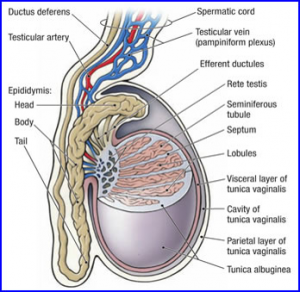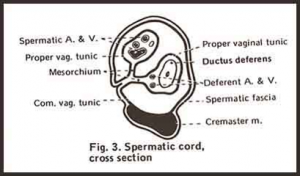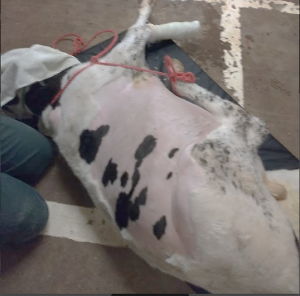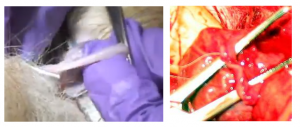Food Animal Male Urogenital Surgery
How to – Vasectomy
Indications
Bilateral vasectomy is performed to create a non-fertile male that can still identify animals in heat and/or retain male secondary sex characteristics (lion mane, etc).
Animals selected as teasers should be manageable, of a size to not cause injury during mounting behavior and have good libido.
Relevant anatomy


Preoperative management
Food restrictions: n bulls, the procedure can be done standing in a chute with no sedation. In most other cases, the animal is only lightly sedated for the procedure and no food withholding is required. If needed for exotic ruminants or other cases, food should be withheld for 48 hours to minimize bloat.
NSAIDs/analgesics:Preoperative NSAID administration is recommended to minimize pain and inflammation. Postoperative NSAID administration is not usually required unless inflammation or pain is evident.
Antibiotics: Preoperative antibiotics are not indicated for routine cases.
Tetanus prophylaxis is recommended.
Local blocks: Lidocaine is used to block the cord and/or the surgical site. A ring block around the cord can help with analgesia.Injection along the proposed incision line and into the cord is quick and effective but does alter the anatomy. 
Position/preparation: Bulls can be restrained a chute with a butt bar in place. Sheep are held in a sitting position. Other animals are cast or sedated until in lateral recumbency. The upper leg should be pulled forward to expose the scrotum. The scrotum is clipped (if needed) and scrubbed prior to and after the local block. Surgeons should glove. A headlamp is recommended.
Surgery Supplies:
- Scalpel blade + handle
- Allis tissue forceps or towel clamps
- Mosquito hemostat x 2-3
- Kelly hemostat, curved
- Needle holders
- Suture scissors
- 3-0 to 2-0 absorbable suture
Surgical procedure
A clean towel or sterile drape can be placed under the scrotum and/or over the animal’s abdomen for suture management. Identify the spermatic cord in the neck of the scrotum. The vas deferens is located on the axial side. Make a longitudinal incision over the axial side of the cord through the skin and subcutaneous tissues. Identify the cord. The vas deferens can be palpated on the axial aspect in some cases, separate from the pampiniform plexus.

Elevate the cord onto the kelly forceps to keep it stable. You may be able to see the white vas deferens on the side, through the wall of the tunic. Incise the tunic that covers the structures within. This step is commonly missed. If the pampiniform plexus is not readily visible, you haven’t gone through the tunic. Once the tunic is open, find the firmer structure that is somewhat isolated. Elevate this on the mosquito hemostat. When relaxed, the vas deferens has a slightly coiled appearance to it.

Clamp the ends of the section of vas deferens to be removed. In older animals, ligate each end to prevent sperm granuloma formation and remove at least 1 cm section. In a mature animal, the contents can be squeezed onto a slide and checked for sperm to verify it is the vas deferens. In younger animals, the section can be removed without ligation (piglets). The skin is closed routinely.

Postoperative care
- Monitor for signs of infection. Open for drainage if necessary.
- Avoid breeding or access to females for 8 weeks.
- Communicate meat withholding restrictions
Complications
There is a risk of removing the wrong structure, particularly in younger animals. Accidental damage to the pampiniform plexus could cause significant hemorrhage. There is a risk of continued fertility, primarily due to recanalization of the ductus. Sperm granulomas may occur.
Videos
Testicular block
Cord block
Scrotal ring block
Cadaver demo
Vasectomy (on a calf but doing it the piglet way)- video link
midscrotal approach in a sheep
Resources
Preparation of teaser bulls – Veteriankey

